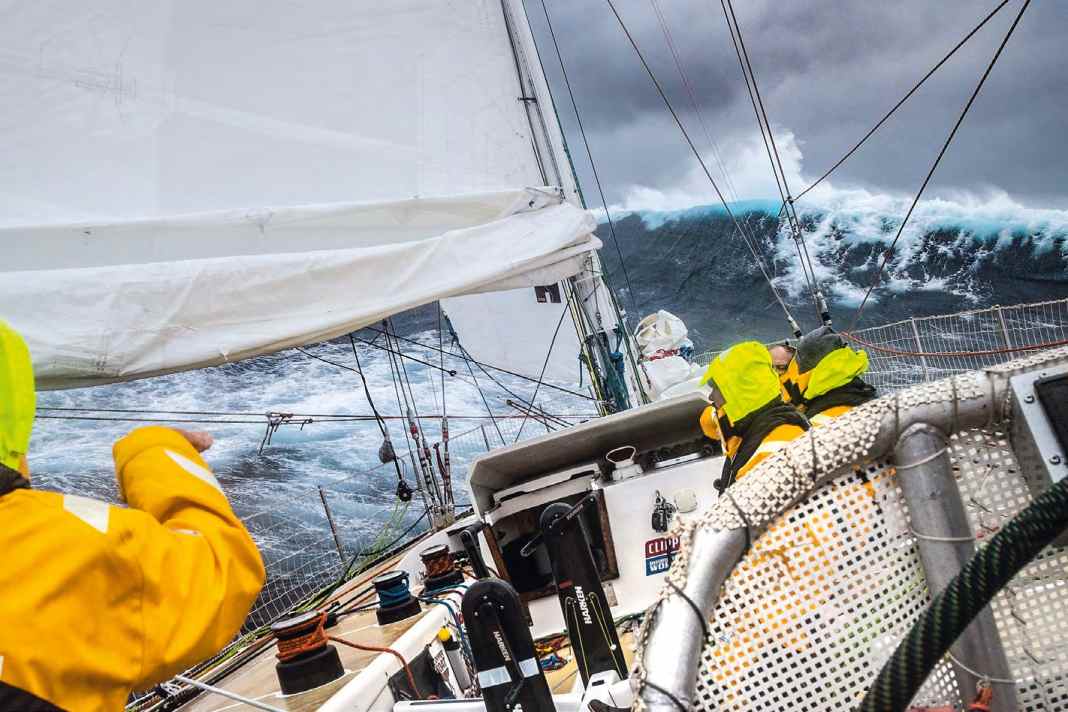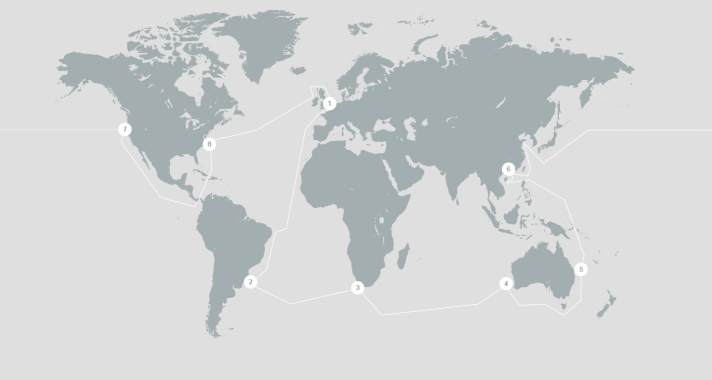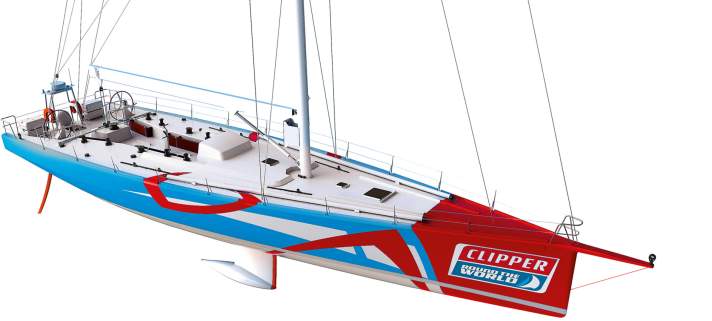Clipper Round The World Race: Amateurs set off to circumnavigate the globe






I've been preparing for the sailing highlight of my life for two years, and now the time has finally come. Two years turn into two months, two months into two weeks, and at some point it's just two days until the start of the race. The tension builds and so does the excitement. Have I organised everything for ten months away? Is my personal equipment complete? Am I as physically and mentally prepared as possible?
But how do you prepare for an Atlantic crossing with a racing yacht? Or for 25-foot waves on the Pacific, for a 40-degree outside temperature, for eight to nine wind forces on a downwind course at night, for a space-sheet ride of more than 15 knots?
In the third week of training before the race, the standard is already reasonably high. Everyone who is still taking part has cleared the hurdles, passed the preliminary rounds and is confident that they are doing the right thing. All the basics such as knots and line work are a prerequisite.
How the crews are put together
Safety comes first, so safety instructions are repeated to us again and again and MOB manoeuvres are repeated daily. Sailing with the asymmetric spinnaker, the gennaker, is added during the third training session. Each boat is equipped with three cloths (code 1 to 3), which are suitable for different wind forces up to 30 knots and 150 degrees angle of incidence, as well as a very light windseeker. As a large part of the race course is planned as a downwind course, fast setting, recovery and continuous trimming of the spinnaker, which measures up to 330 square metres, is a prerequisite for a successful finish. In addition, of course, jibing under spinnaker as well as possible MOB manoeuvres. There it is again, the safety drill.
The Crew Allocation Day takes place in Portsmouth around three months before the start of the race. At this event, which was well attended by around 450 people, we found out which team we were sailing in and who was in charge of our boat. The event was a bit like a mixture of an insurance agents' conference and a Helene Fischer concert, but most of the attendees clearly enjoyed themselves despite the lengthy presentations. The individual crews were allocated by means of light bands on their arms, which took quite some time with eleven boats and eleven teams. As the penultimate crew, I was assigned to "Team Hannah". Spread over the eight legs around the world, our team consists of a total of 50 men and 17 women aged between 23 and 69 from 19 nations, with nine people opting to sail around the world in their entirety, three women and six men on board.
The route of the Clipper Round The Race 2023-24

The race starts in Portsmouth on 3 September. From here, the first leg leads via a stopover in Cadiz, Spain, to Punta del Este in Uruguay (approx. 7,250 nm). The journey continues to Cape Town (4,200 nm) and from there through the Indian Ocean to Fremantle in Western Australia (5,500 nm). The fourth leg will land in Sydney (4,000 nm) at the end of the year. At the beginning of 2024, the fleet will sail on to Zhuhai in China, with one or two as yet unnamed stopovers planned (6,300 nm). The sixth and longest leg will stop in Qingdao and then sail across the northern Pacific to Seattle (8,000 nm). During the seventh leg, the field will travel down the west coast of the United States, through the Panama Canal and back north up the east coast to New York City or Washington (7,200 nm). The final leg then leads back to England, where the winning team will be crowned at the end of June/beginning of July 2024 (4,400 nm). In total, the fleet will sail around 40,000 nautical miles in around eleven months.
With its own crew and our skipper Hannah we started the fourth and final training session in mid-June. As we were unable to assemble a full crew from our team, we were grouped together with another team. However, the watches were organised so that only members of one team were on deck most of the time. As our part of the team consisted of only six people, the work was correspondingly demanding, but also very instructive: steering, trimming and hauling in a 330 square metre spinnaker in the middle of the night with only six people is no easy task, but such challenges prepare you perfectly for the actual race.
Final training with simulated race
The highlight of the training was a simulated race with several yachts from the south of England through the English Channel to France and back. The almost 200 nautical miles were sailed in about 24 hours, depending on the wind, so each watch was responsible twice. A few hours before the race, we practised the Le Mans start: the team is only allowed to prepare the two headsails, but not set them. Ten minutes before the start, the crew gathers at the back of the cockpit and is only allowed to rush forward at the start signal to hoist the Staysail and Yankee. The boat is rigged as a cutter, so there are two smaller headsails instead of a larger genoa.
The simulated race is the first real opportunity to get a taste of regatta racing, as manoeuvres are used here that were previously only addressed in theory, if at all: When does the crew perform a gybe, when and how do they swap a Code 2 for a Code 1, what time is allowed for this, and what does the ominous "Velocity Made Good (VMG)" actually mean. Anyone not already familiar with the world of racing will learn the first basic rules of competitive sailing here at the latest.
Scoring like the Ocean Race
Similar to the Ocean Race, the scoring is not based on the time sailed or a calculated time, but on points awarded in the same way as the ranking. One or two races are sailed per leg and scored with 1 to 11 points; the more points, the higher the position. Each team can earn additional points through ocean sprints of several hundred miles, in which the boat and team are asked to do much more than in the longer race stages.
With the "gates", the race organisers have come up with a tactical chicane: virtual gates are set up outside the racing line, which can score up to three additional points per race. If a team decides to pass the gate, it risks losing time. Whether the gain in points cancels out the loss of the racing line remains the tactical decision of the skipper. During the entire race, a team can use a joker once to gain double points for a race.
The yachts for the race around the world: Clipper 70

Technical data Clipper 70
- Construction method:GRP sandwich
- Total length:23,00 m
- Width:5,65 m
- Depth:3,00 m
- Weight:31,7 t
- sail area:291,6 m²
- Gennaker:330,3 m²
- Sail carrying capacity:5,4
The Clipper 70 operational yachts designed by Tony Castro differ from their predecessor, the Clipper 68, in that they have two steering wheels and a double, redundant rudder system. All halyards and outriggers are led into the cockpit, which greatly simplifies teamwork between helmsman and crew. The navigation area has been moved from the centre of the boat to the stern and is now only separated from the helm by a hatch for better communication. The galley area of the 70 yachts has also been centralised and designed in a U-shape, with benches on the port and starboard sides so that the crew can spend the free watch together more easily. All eleven Clipper 70s are identically equipped. Eleven sails are on board the cutter-rigged offshore yacht. If a torn sail cannot be repaired and has to be replaced, the team is penalised.
There are 20 berths below deck, as well as two small toilet cubicles. The ships are designed for a crew of 21, plus skipper and AQP (Additional Qualified Person). As they are usually sailed in two watches, only half of the berths are required. The absence of any luxury is reflected in the tiny hand shower, which is powered by salt water, and the size of the berths, which can be as little as 60 centimetres wide depending on their position in the ship.
The boats are conventionally built from GRP sandwich, but thanks to their large sail area they still achieve a high sail load factor of 5.4 and thus a very perfomant power-to-weight ratio.
Safety first: The safety regulations for the Clipper Round The World Race
The race organisers send the current status of the race to the crews every six hours; spectators can view hourly updates on the Clipper website. Once per stage, a team can activate "stealth mode" so that it is invisible to other participants and spectators for a period of 24 hours. A crew can also receive penalty points, for example for loss or irreparable damage to equipment including sails, for crossing areas that have been closed by the race organisers (for example traffic separation zones or restricted military zones), or for deviating from the course in areas that are too far south and therefore at risk of ice, for example on the leg between South Africa and Australia.
Safety is the top priority for organiser Clipper Ventures, and this is no empty phrase for the English. Each of the unitised yachts has five compartments that can be sealed off independently of each other in the event of water ingress. The bow is a single crumple zone that absorbs a relatively large amount of damage in the event of a head-on crash. Two independent MOB systems are installed on board as well as three large life rafts for eight people each. Each participant receives their own brand-new Spinlock lifejacket with a pressurised release system (instead of the sensitive salt tablet used in the past) and a lifeline with innovative carabiners. For this purpose, several redundant jackstays are installed along the entire length of the ship and also on the mast, bow and in the steering area. The waistcoats are equipped with their own AIS, which is triggered by water pressure and sends a distress signal. The marker buoy also has AIS, which makes it much easier to find in the dark and in rough seas. Breakwaters are installed in front of the steering wheels to minimise the risk of waves washing overboard or injuring the helmsman.
And the safety rules are strict: from 15 knots of wind and/or in the dark, the crew have to picket. Apart from crossing quickly, you are not allowed to stay in the CCZ, the Cockpit Cautionary Zone, an area about two metres long between the rear grinder and the steering wheel. And if the wind angle is greater than 90 degrees, you have to crawl under the traveller, which is only 40 centimetres high, on the way to the stern (and back) to avoid being caught by the mainsheet in the event of a patent jibe. This is a challenge in a full offshore jib.
Adventure or supervised sailing?
The extensive safety systems and repeated exercises ensure a constantly growing on-board routine in handling the boat and equipment. However, a certain amount of excitement remains before the start of the race, along with the recurring question: "Why am I actually doing this?"
However, such thoughts are quickly put into perspective when Sir Robin Knox-Johnston, sailing legend and clipper founder, passes us in his "Suhaili", greeting us: This man has sailed around the world single-handed and non-stop, without GPS, Grib data or any other technical bells and whistles. What am I actually worried about?
- Further information at clipperroundtheworld.com
The author: Andreas Zerr. Born in Hamburg in 1971, he gained his first sailing experience at the age of eight in an Opti and has been sailing his Ohlson 8:8 in the western Baltic Sea since 2019. The freelance film producer knows areas such as the Atlantic coast, North Sea, Channel and Mediterranean and occasionally works as a training skipper on SKS trips from Kiel.

